The Windsor Ruins of Mississippi – Architecture & Photos
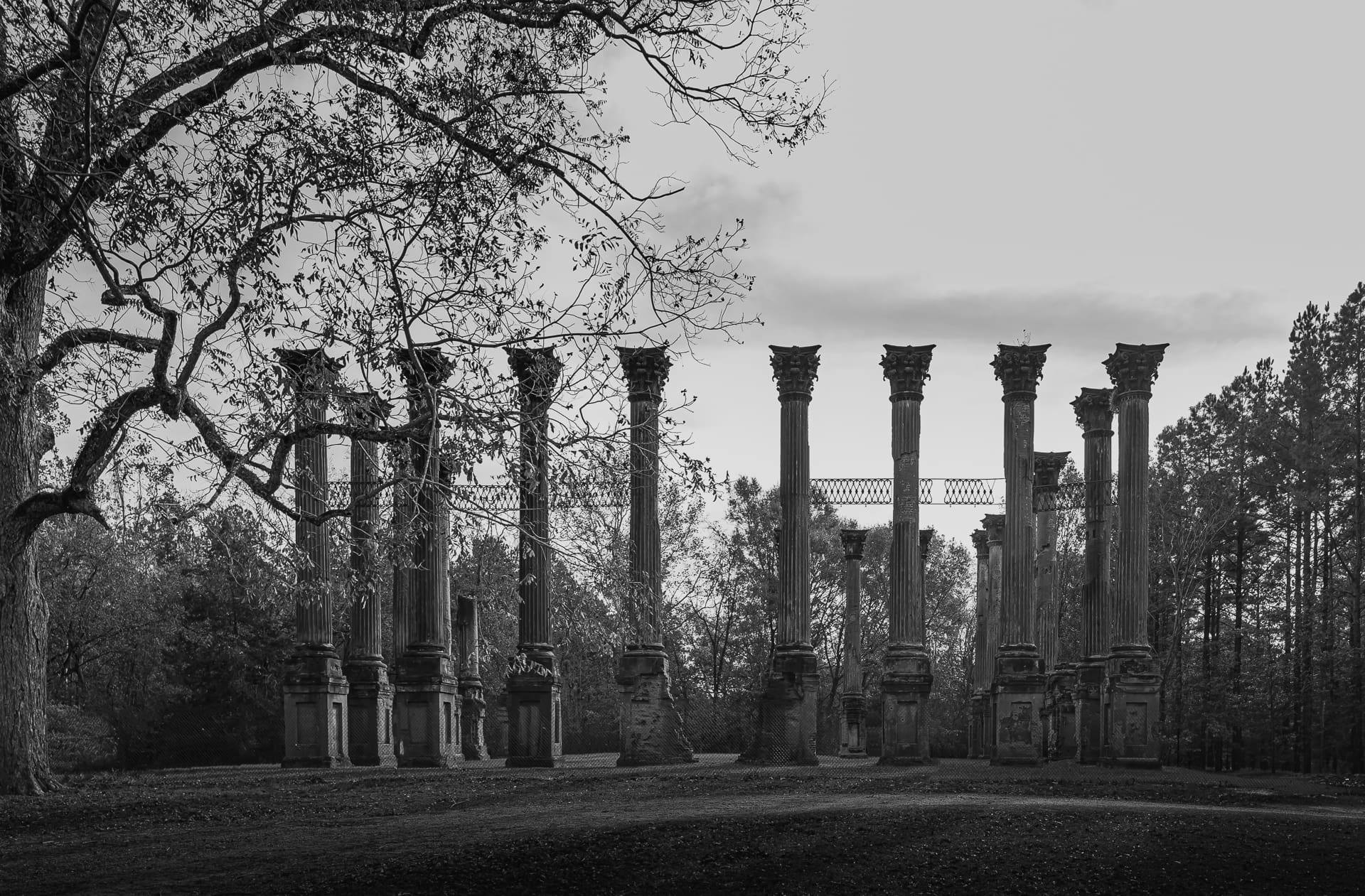
The Windsor Ruins are the beautifully haunting remains of the largest Antebellum Greek Revival Mansion in Mississippi. Upon arriving, they instantly conjured up wonderful memories of a childhood trip to the British Isles where ancient ruins are a much more common sight. In the US, we have a tendency to either demolish or restore the amazing architecture of years past. We rarely preserve the sites of architectural ruins but, thankfully, Windsor is one of the few exceptions.
Featured in the 1957 film “Raintree County” and the 1996 film “Ghosts of Mississippi”, The Windsor Ruins are located in Claiborne County about 10 miles southwest of Port Gibson, Mississippi. All that remains of the former cotton plantation and its architecture are 23 standing Corinthian columns with iron capitals and, just maybe, a few spirits—if you believe in that sort of thing.
Windsor Plantation
Located on a massive 2,600 acre farm, Windsor Plantation was built by wealthy cotton planter Smith Coffee Daniell II and designed to be a raised Greek Revival architectural style by Maryland architect David Schroeder. Shroder also designed the Greek Revival Mansion “Rosswood” 14 miles Southeast of Windsor.
In the Antebellum South, it wasn’t enough to simply build a home. The excessively wealthy had to build the biggest and best home their area had ever seen. This trend peaked right before the Civil War when a massive amount of wealth was located in the South due to King Cotton.
Windsor was to be no different. Beginning in 1859, the 17,000 square foot plantation home was to be set by twenty-nine 40’ columns, wide verandas, interior bathrooms, school room, doctor’s office, study, library, ebony-framed mirrors, and over 20 rooms with their own fireplaces made of Georgia and Tennessee marble. Situated on top of the home was a large observatory overlooking the Mississippi which, legend has it, hosted Samuel Clemens (Mark Twain) as he plotted course during his riverboat captain days just before the Civil War. Twain supposedly wrote about Windsor in one of his books comparing the mansion to a college due to its size, but I’ve been unable to locate the specific passages.
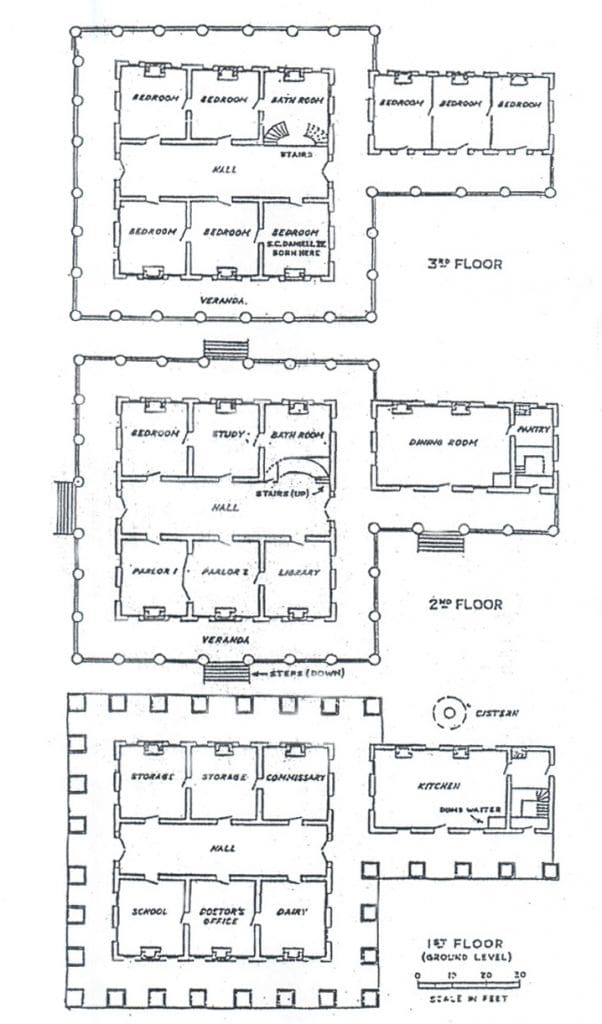
The columns were the best that money could buy. Forty feet in height and sitting on 10’ tall paneled brick plinths, the fluted columns were crowned with half-ton ornate iron Corinthian capitals and joined with ornamental iron balustrades.
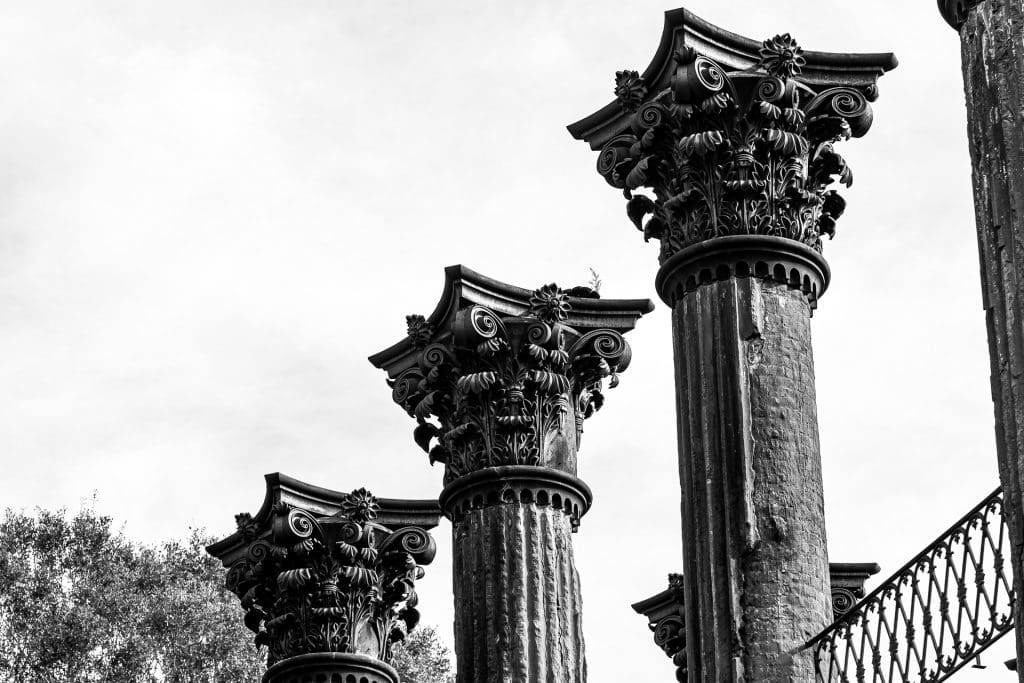
The column capitals, balustrades, and cast iron stairways were manufactured in St. Louis and shipped down the Mississippi to the Port of Bruinsburg nearby. The skilled labor, artisans, carpenters, masons, and painters on the home were sent in from the northeastern US and Europe. The hard labor was completed by Daniell’s slaves.
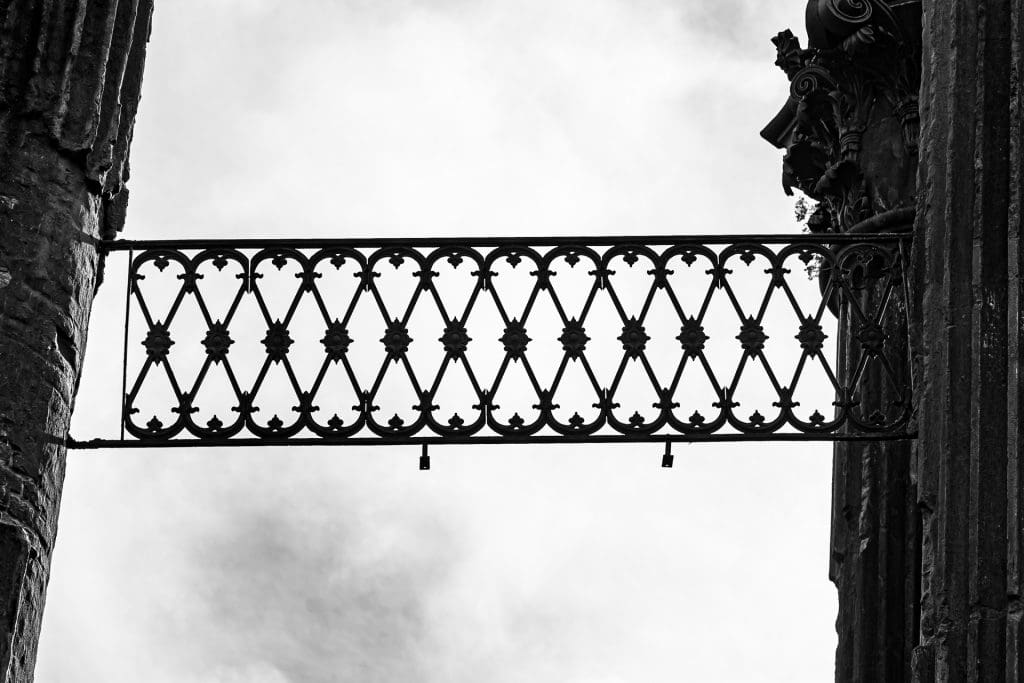
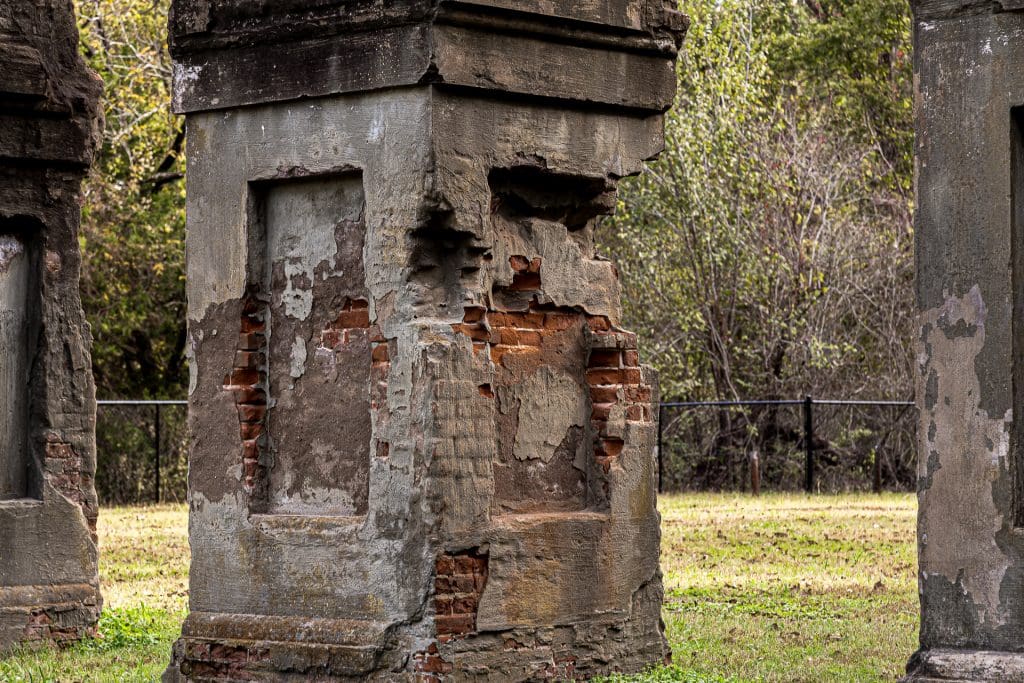
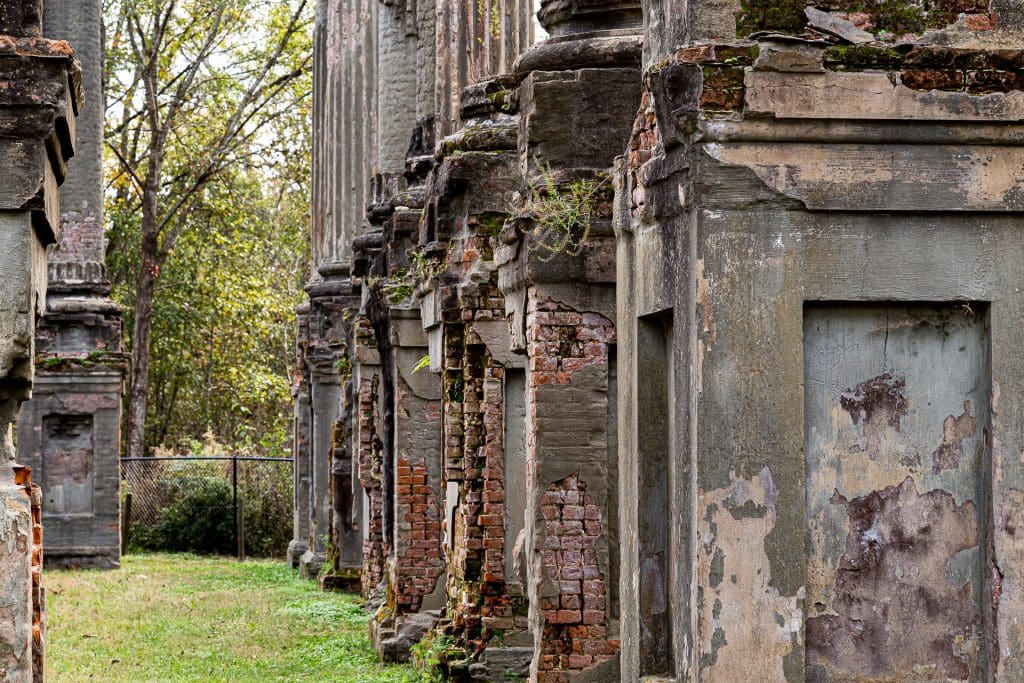
Construction on Windsor Plantation was completed in 1861. Most people think that Windsor was named after the famed Windsor Castle in England, but that doesn’t appear to be the case. Instead, the name appears to have been cast by the slaves working on the home. As the winds swept through the columns and passed the capitals, it made quite the unique sound; almost as if the columns spoke the word “Windsor” over and over. The name just stuck.
His new home freshly finished in 1861, at the age of 32, Daniell had amassed a multi-million dollar empire totalling more than 20,000 acres of land in Mississippi and Louisiana and no fewer than 300 slaves. He spent $175,000 on the home. Adjusted for inflation, that’s about $5,000,000 in today’s money.
Unfortunately for he and his family, Daniell wouldn’t get to enjoy it very much. On April 28, 1861, mere weeks after completion of Windsor, Daniell died. Not much information is available about the cause of his death, but the only source I found to mention it proclaims that he died of a heart-attack.
The Civil War Comes to Windsor
Many southern homes and plantations were destroyed as a result of attacks and Union policy during the Civil War, but Windsor was fortunate. It survived mostly unscathed by the war, but it didn’t remain untouched. During the early years of the war, Windsor’s observatory was frequented by Confederates as they watched Union troop movements up and down the Mississippi and surrounding areas. As it turns out, Union troops were also watching the Confederates.
Just before the Federal Campaign on Vicksburg began, Catherine Daniell, Smith Coffee Daniell’s wife….and cousin, was hosting one of the parties that would become commonplace at Windsor over the next 30 years. Several neighbors and even a few Confederate Officers attended the covered dish party. A knock on the door after everyone else had arrived prompted the servant (or slave) to answer the door. Standing there were a few more party guests. The servant welcomed them in but everyone quickly realized that they were Union soldiers and they weren’t there to party. They were there to capture the Confederate Officers. As told by one of the attending Union Officers:
So we entered and there in the parlor of the house was quite a party, singing and laughing and having a fine time generally. Among them were three Confederates dressed in their gray uniforms. I walked in and went up to the one that seemed to be in command, touched him on the shoulder and inquired, “Are you a Confederate officer?” He promptly replied, “Yes, I am.” At this the singing stopped, and the ladies present came around and insisted that we Yankees were not gentlemen and that we should not spoil their evening by arresting and taking prisoners these three Confederates. The ladies grew very boisterous and attacked us with their fists and fingernails, and refused to allow the arrest. The lieutenant (posted at the rear of the house) and his detail came in from the rear and we then took the three rebels prisoners and marched them down to the river edge from Windsor to where our yawls had been left, and loaded them and went back up the river to Grand Gulf where the gunboat was tied up. It was late at night when we arrived there. We then took them to Vicksburg where they were placed in prison.
– Union Officer in a letter home
Soon after, the Vicksburg Campaign began and Ulysses S. Grant with 10,000+ Union troops landed at the Port of Bruinsburg just West of Windsor. They proceeded to climb the hill to take control of the mansion.
When the troops debarked, the evening of the 29th (April), it was expected that we would have to go to Rodney, about nine miles below, to find a landing; but that night a colored man came in who informed me that a good landing would be found at Bruinsburg, a few miles above Rodney, from which point there was a good road leading to Port Gibson some twelve miles in the interior. The information was found correct, and our landing was effected without opposition.
– Ulysses S. Grant
The first plantation we came to (on the high ground overlooking the river) was the most magnificent I ever saw. The house could not have cost less than a hundred thousand & perhaps half as much more. It was three stories brick & completely surrounded with a row of massive Corinthian pillars extending from the ground to the roof.
George Smith, Union Soldier, May 6, 1863
Windsor would serve as a staging ground for the imminent Battle of Port Gibson/Bruinsburg on May 1, 1863 and subsequent operations, namely as an observation station and field hospital. The hospital would go on to treat over 400 soldiers on the grounds and see more than 30 dead and buried as the Daniell family were sequestered to the 3rd floor of their own home.
At least one other Civil War casualty fell on the grounds. During the aftermath of the Battle of Port Gibson and while the mansion was still under occupation of Union soldiers, a Union soldier was shot and killed in the front doorway of the home. Once General Grant heard of this, following the common retaliatory practice of the war, he sent troops to burn the mansion to the ground. Somehow, Catherine talked the soldiers out of burning her home. Instead, they chose the barn to serve as their fiery carrier pigeon; this is the price for wrong action against the Federals.
Outside of being the center staging ground for a battle, being the scene of a Union solider’s murder, serving as a field hospital and having 30+ soldiers buried on their property, the Civil War was uneventful for the Daniells. As you probably figured, that statement is wrapped in a light blanket of sarcasm but, truthfully, that’s relatively uneventful when compared to some of the other places I’ve covered.
Fire Transforms Windsor Mansion into the Windsor Ruins of Today
The Civil War came to a close and, even though the Daniells had lost a staggering amount of wealth, they weren’t exactly in the poor house. During Reconstruction, they leased out a substantial amount of their land holdings for steady income and maintained a high standard of living.
The Daniells remained at Windsor over the next 25 years or so and hosted social gatherings regularly. The gathering on February 17, 1890, though, proved to be the final party the Daniells would ever host at Windsor. That day, as told by Smith Coffee Daniel IV:
About 10:30am, they went up to the observatory, including myself, to get a good view of the river and Louisiana. Coming down, a young man threw his cigarette into some trash made by carpenters doing some repairs on Saturday…soon after, a house girl hollered, “FIRE!”…and I was told to leave the house.
Smith Coffee Daniell IV, grandson of the original owner of Windsor, recalling the day of the fire.
The blaze took nearly everything from Windsor including all the personal property, drawings and photographs of the home. All that remained were the columns, balustrades, cast iron stairways, and some pieces of bone china.
I’ve read some reports say that it was a worker that dropped the ashes or that it happened at night or one of several other variations, but if the SCD IV quote is accurate, I’ll go with the first-hand account.
A local paper reported the aftermath:
The palatial dwelling on Windsor plantation, near Bethel Church in the southwestern part of the county, burned to the ground last Monday. The fire was discovered about noon, but, it could not be checked, and in a few hours this splendid country site was in ruins. Most of the contents were also destroyed. These included not only a great deal of elegant furniture, but many costly heirlooms and much other household property of value, such as jewelry, silver plate, a large library, etc. This residence, probably the most magnificent in the state, was erected by Mr. Smith Daniell shortly before the war. It was a brick structure, comprising 25 rooms and was completed, we believe, in 1859. The building cost $140,000 and furniture $35,000 additional, bringing the total cost to $175,000. We regret to learn that neither upon it, nor its contents, was there any insurance.
With her home of three decades destroyed, Catherine Daniell and her family moved to a nearby plantation, fittingly, called Retreat where she lived 13 years before dying at the age of 73.
The Windsor property remained with the family until 1974 when Smith Coffee Daniell’s descendant donated the ruins to the State of Mississippi for historic preservation.
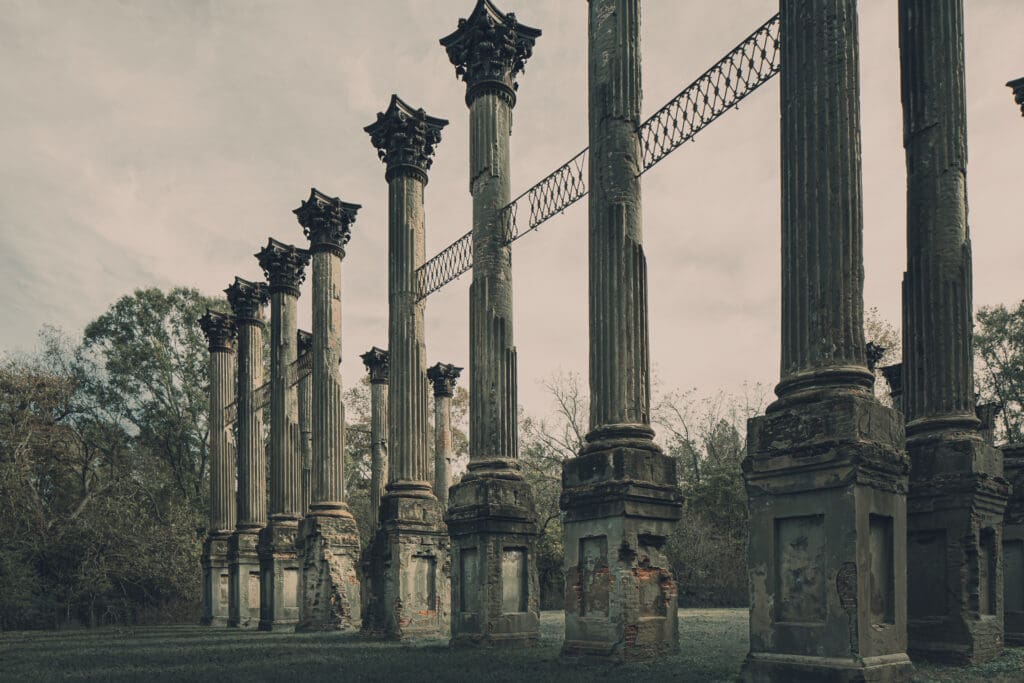
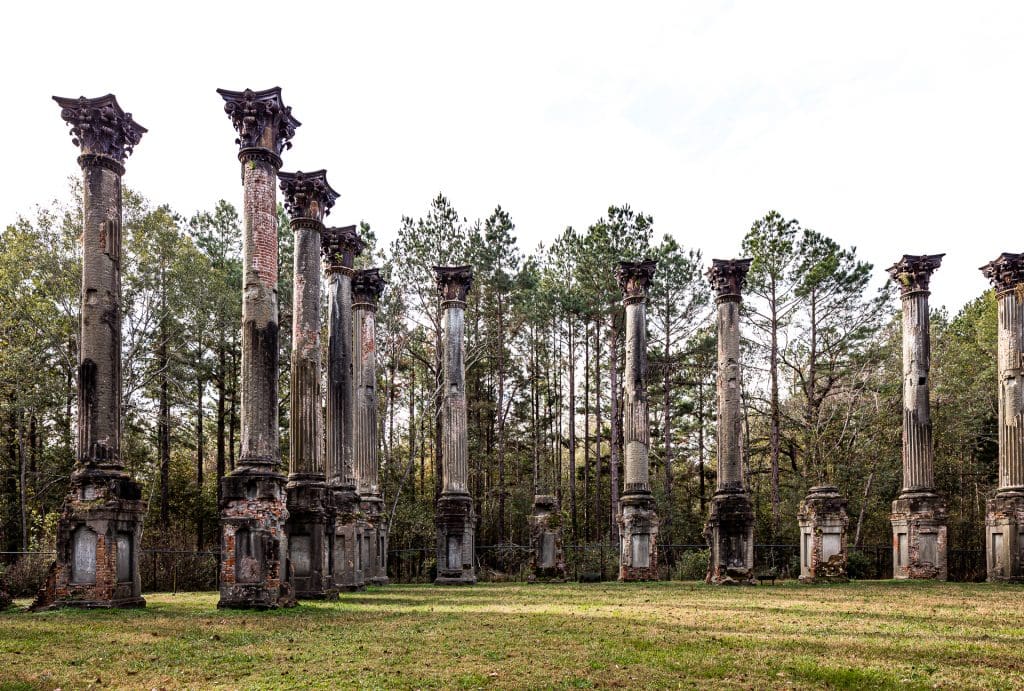
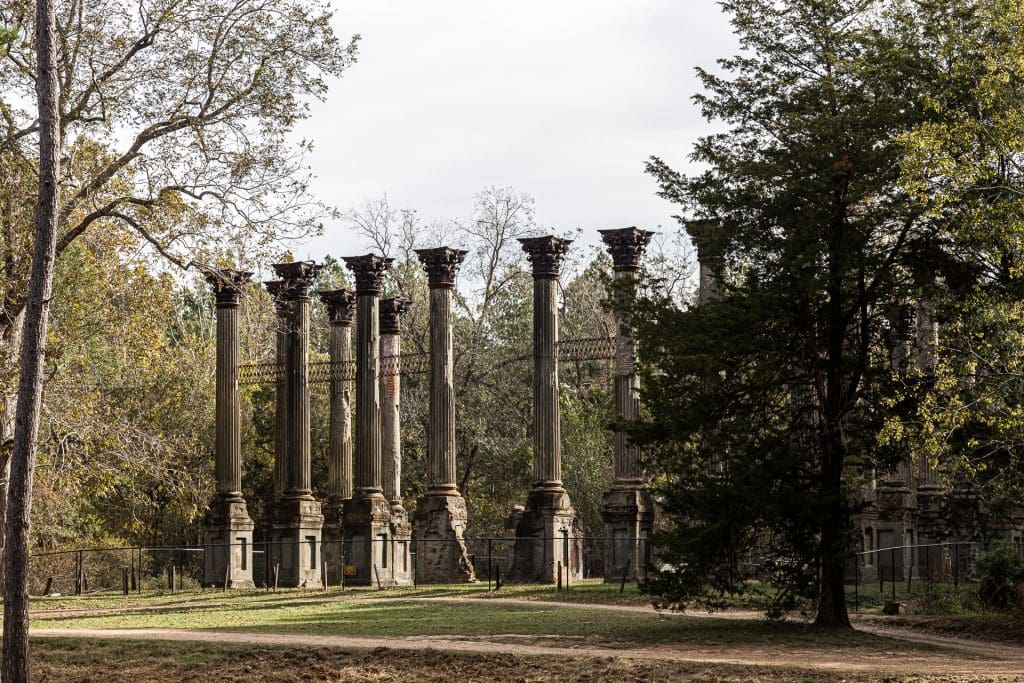
The Hauntings of Windsor Plantation
War, Murder and Fire. Typically, those are 3 things that’ll haunt the shit out of your place or, at the very least, give it a haunted reputation. It’s no surprise that there are quite a few tales of ghosts and mysteries surrounding the ruins.
That being said, much like the Ghost Town of Rodney just a few miles away, stories are difficult to come by at a place that isn’t actively occupied….and hasn’t been for almost 130 years. Most are very vague descriptions of random accounts. All I know is that I went on a cloudy, foggy morning and it was an interesting, unforgettable experience. It wasn’t necessarily a creepy or paranormal experience, but the ruins have their own “vibe.”
Later in the afternoons and evenings, it’s quite common for visitors to report the sounds music and laughter as if there’s a party going on. Another oft reported sight is that of a blue-coated soldier patrolling the front door and walking the staircase…that no longer resides at the property.
The most common sight is that of a man in period clothing pacing the grounds. Presumably, the apparition is Smith Coffee Daniell himself. Many people have commented that he “looked so real that I went over to speak with him and he disappeared.” Groups of paranormal investigators have investigated the grounds and return with the same types of experiences.
One group of investigators caught a hellaciously creepy EVP one night. A ghost with a guilty conscience spoke the phrase, “it’s all my fault” quite clearly into one of the recording devices.
The Mystery Windsor’s Architecture
For more than 100 years, the appearance of the mansion was a bit of a mystery. Sure, there were several attempts to recreate the exterior based on those big-ass columns still standing, but no one nailed it. How could they? There were no surviving photos or sketches of the place. Well, that was the prevailing wisdom among historians.
In the early 1990’s, everything changed. The personal diaries and papers of former Union Captain Henry Otis Dwight were discovered and examined at Ohio State University. To the delight of Civil War buffs and historians across the South, a sketch of Windsor Plantation was found.
On May 1st, 1863, following the Battle of Port Gibson, Henry Otis Dwight of the 20th Ohio, sat down to sketch the mansion. Shown below, it remains the only known first-hand account or representation of the mansion in existence.
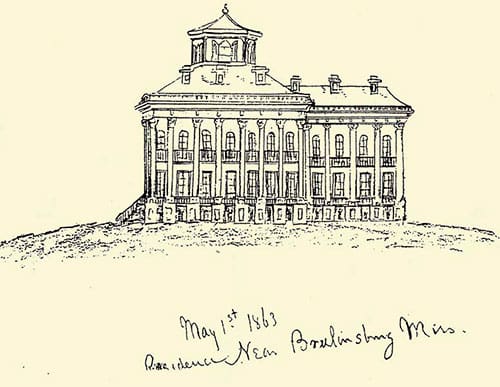
For Prints and Digital Copies
I do sell prints and digital copies of these images. An online store is coming soon, but in the meantime, please contact me for pricing and images.
